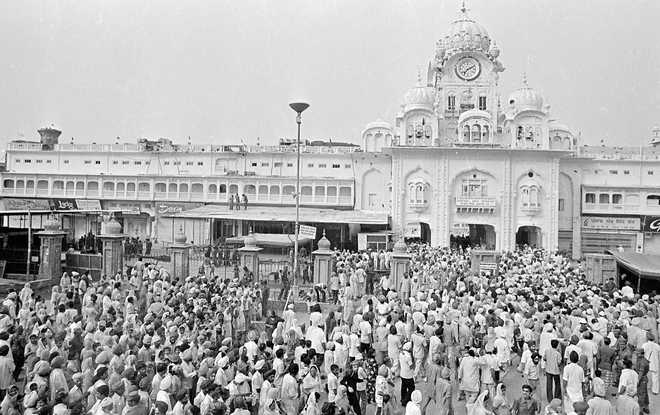A suggestion for an Indian government in the future oriented towards reconciliation could be to take a bold step in following South Africa’s example of establishing a truth and reconciliation commission.

Pritam Singh
Professor, Oxford Brookes University, UKJUNE 6 marks the 34th anniversary of Operation Bluestar. With one-third of a century on, how do we describe this action, and what meaning do we attach to it? Do we describe it, as the Congress ideologists did then, as a holy task undertaken by the Indian military to clear the temple of the militants who had taken control of it? Or do we describe it, as some Indian nationalists and Leftists do, as a sad and necessary action to defeat an imperialist conspiracy to disintegrate India? Do we celebrate it, as some Hindu nationalists do, as a successful assertion of India’s Hindu supremacy against the Sikh minority’s separatist aspirations? Or do we condemn it, as Sikh and Punjabi nationalists do, as a genocidal attack on Sikh dignity, assertion and identity? Perhaps, we decry it, as most human rights defenders and Leftists do, as a tragedy resulting in the deaths of thousands of human beings — pilgrims, priests, Sikh combatants and Indian army men?The contesting descriptions of Operation Bluestar and the meanings attached to it are reflections of serious fault lines in the Indian society and polity. To say that there would never be a consensus on how to describe and signify this military action may be unreasonable and ahistorical. But to say that there is little likelihood of a consensus in the foreseeable future would be alluding to an uncomfortable truth about the fractured nature of Indian nationhood. However this operation is described and whatever meaning is subsequently attached to it, one thing is clear: one day, everyone else might want to forget it — and, might succeed in doing so — but this will never be true of the Sikh community.
The third ghallughara
Operation Bluestar has become an integral part of the Sikh collective historical memory. It has become the third ghallughara (holocaust) in Sikh history — the first referring to the massacre of some 10,000 Sikhs in 1746; the second to the even larger massacre of Sikh men, women and children in 1762, when 30,000 (nearly 50 per cent of the population) were slaughtered in Punjab. Today, the available evidence suggests that many (though not all) gurdwaras in India and abroad include references to the third ghallughara in their daily ardas, or prayers.The most reliable estimates of the total number of deaths during Operation Bluestar are anywhere from 5,000 to 7,000. Yet, a crucial difference between the third ghallughara and the previous two is that this massacre occurred in the Golden Temple, while the first two took place on open battlefields. This gives an added religious dimension to the significance of the military action: a much larger number of Sikhs died during Partition, but the 1947 deaths are not seen in terms of attacks on and in defence of religion. In religious terms, the largest Sikh loss in 1947 was the fact that the Nankana Sahib gurudwara — marking the birthplace of Guru Nanak, the founder of the faith — was suddenly located in Pakistan. This, too, was a loss that today figures in the daily ardas.
Human rights approach
What should be the human rights approach in dealing with the complex situation of destruction, loss and pain associated with Bluestar? It could be to put forward a position of truth, accountability and justice as a methodology to study and a tool with which to deal with this painful situation. One can hope that truth and justice can heal the wounds, and there can be sound grounds based on an understanding of human history that such a hope is not wholly unfounded. However, one is also simultaneously troubled that the truth may never be allowed to come out and that justice may never be done because of the complicated conflicts of competing nationalisms implicated in this tragedy. Another dimension of human history which creates pessimism is that history is also full of intractable conflicts and continuing injustices.As for how to think about Bluestar, first and foremost, it was a massive human tragedy. It was a tragedy that could have been avoided if — and that is a big if —- Indira Gandhi had had a larger vision to reach a political settlement with the moderate Akali leadership. Most Akali Dal demands — regarding federal decentralisation, river water rights, territorial readjustment and the transfer of Chandigarh to Punjab as its capital — could have been negotiated. In 1985, Rajiv Gandhi agreed in the Rajiv-Longowal Accord to each of these demands, plus many more. It is a different matter that he implemented none.Indira Gandhi’s political calculations — those of using the ‘Hindu card’ for electoral victories — led her to deliberately choose a dangerous path of confrontation, first with the Akalis and eventually with the entire Sikh community. She paid for this miscalculation with her life, but still left Punjab and India communally scarred and polarised. Sikh nationalism was defeated militarily, but Hindu nationalism was unleashed so powerfully that the Hindu nationalists succeeded within a few decades to capture the Indian state.Regarding the demands that led to the Akali agitation of the early 1980s, the situation today remains where we were back then. As far as accountability for atrocities committed during Bluestar and subsequently during the conflict between the Indian state and the armed opposition Sikh groups is concerned, one suggestion for an Indian government in the future oriented towards reconciliation could be to take a bold step in following South Africa’s example of establishing a truth and reconciliation commission. No one wants history to be repeated. The least anyone can do today is to remember those thousands — pilgrims, priests, politicians, traders, militants, policemen and soldiers — who became victims in the tragedy of the third Sikh ghallughara.
